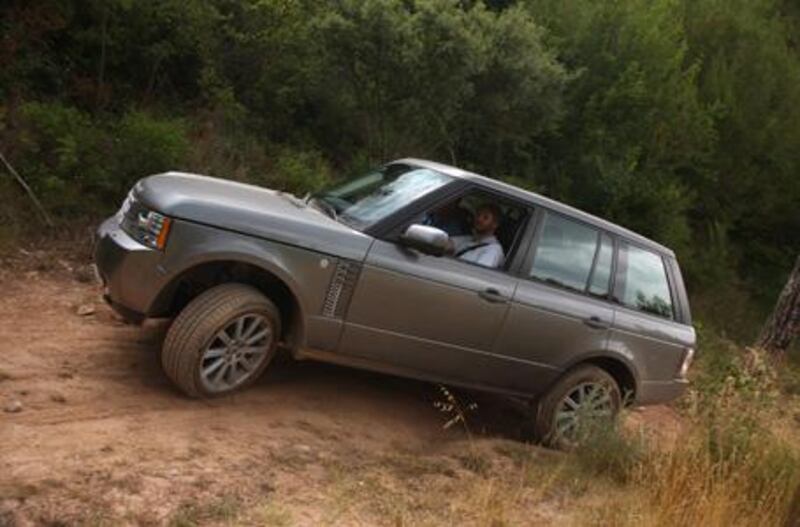A couple of years ago, during an idle moment, I looked at my mobile phone and pondered what more beyond camera, radio, 3G internet connection and a thingie that calculates your average daily calorie burn could possibly be added for future generations to enjoy. I could think of absolutely nothing. Had the portable telephone, I wondered, reached the limit of its functionality? Was there anything else left for it to perform? Had the mobile phone, like a hare, overtaken the tortoise of technology?
Obviously I was wrong, especially given how Motorola has developed an epidermal attachment that shocks its master on receipt of a text. And one day I'm sure they'll even create a feature that puts an end to headlines like, "Girl falls down manhole while texting, lawsuit pending." The same, surely, can be asked of cars: what more can be added to a luxury vehicle to give it a competitive edge? To their credit, the designers at Range Rover have with the launch of the 2010 upgrade, taken things one step further. But surprisingly they have done so by adapting 20-year-old technology into latter-day futuristic features. And at the same time, they have managed to answer the eternal question of what to give a rich man who already has everything.
The engines may have been upgraded to 5.0 litres with greater power and fewer emissions, and the exterior might now contain a bevy of new design features, but the two standout features of the Rangie's interior come from the days of Datsun and predate Trivial Pursuit. The first big draw is the electronic dashboard, and what a beauty it is. Forget about those loathsome jobs in 1980s Renaults and Citroëns - the ones that tended to give a speed reading of 538kph while you were sat at the lights, and contained more colours than the cover of Sergeant Pepper - the new Range Rover's TFT display, as it is called, is accurate, attractive and extremely versatile.
It came about by designers answering criticism from numerous customers that the dash was dull; as the part of the car the owner saw the most, it gave the impression that the Range Rover was staid and technologically past it. As a result, the manufacturer has now put much stock into its dash to prove that the marque is evolving and advanced. As well as being a beautiful display, with current speeds and revs highlighted while unused parts of the dial are faded out, the new technology allows redundant areas of the gauges, such as the 100 kph-plus area of the speedo while in off-road mode, to be removed from the screen and replaced by traction analytics.
Most importantly, though, it is funky and serves as a talking point, as does the dual-view screen in the centre stack. Once again, this is taken from an 1980s fad. Remember those cards Kellogg's breakfast cereals were fond of, the ones that showed an image that changed depending on the angle from which you viewed it? This is the hi-tech equivalent, allowing the driver to see the satnav directions while the passenger watches the television at the same time.
Personally, I can't imagine anything more annoying than trying to fight my way onto the right road while a Turkish soap opera's heartfelt laments bang out through the speakers. But I have to admit it is a real talking point and the sort of thing a Range Rover owner, the type who demands all the latest technology, would sell his mother-in-law to own. These aren't the only new features, but they will certainly the most commented on. Like so many cars, the 2010 Range Rover has been "redesigned, from top to bottom".
We tried out the Supercharged variant during the car's official launch in the hills around Barcelona. Immediately it is noticeable that a new, leaner grille has been added to the nose, and this, along with the redesigned lights, makes the car seem lower slung and sporty. The rear, too, gets new lights, with three-strip indicators between the old two circles. The jury's still out on whether these look dinky or daft, but they certainly give a little bit of extra flair.
Otherwise, the new Range Rover retains all the design cues that have made it a classic, and the layman would be hard-pressed to tell the difference from the previous model. A really significant change has taken place under the bonnet, with the installation of the first ever power-plant specifically for a Range Rover. The old BMW 4.2-litre supercharged now makes way for a 5.0-litre V8. While the basic version now cuts a second off the erstwhile car's 0-100 kph time, achieving the dash in just 7.6 seconds, the Supercharged edition makes it in only 6.2 seconds, thanks to a 29 per cent increase in power to 510 hp. A six-speed ZF gearbox provides the conduit between foot and cylinders.
These figures, combined with post-two ton bulk, require some serious stopping, and the six-piston calliper, 20-inch front brakes are ample and even verge on the light side. Altogether, with Range Rover's adaptive dynamics system and modified chassis and dampening, the Supercharged handles like a hot hatch, in spite of its gargantuan size and thrust. Additional mechanical features include a new sand-launch capability and rock control that work well for off-roaders in this region, giving greater certainty on uncertain surfaces. There is also blind- spot monitoring, adaptive cruise control, advanced emergency brake assist, dynamic bend lamp operation and automatic high-beam assist, for those who like to play it safe.
But none of these features are quite as impressive as the electronics on the fascia. Billed as world firsts in the "world's most innovative SUV" by Range Rover, they steal the show. It just goes to prove, like the calorie counter in my mobile phone, that nifty things such as TFT displays will always trump features of substance when it comes to defining luxury motoring. motoring@thenational.ae











